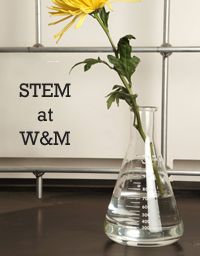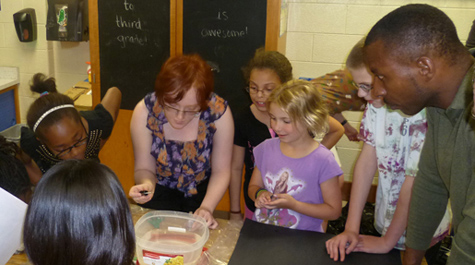STEM Outreach: Lasers and candy and bosons, oh my!
Editor's note: This is one of a series of stories from Ideation magazine on the various STEM-outreach initiatives at William & Mary, programs that reach out beyond the walls of campus to increase understanding and appreciation of the STEM disciplines—science, technology, engineering and math. The full series of stories is available here.
 Joshua Erlich
was not teaching a cooking class when he talked about fat content, taste and
mouth feel to an audience of several dozen members of the Williamsburg
community one bright Saturday morning. While this collection of high school
students, members of the College, neighborhood residents and others came for
chocolate, they left with the understanding of the science that produces the
velvety sweet delicacy.
Joshua Erlich
was not teaching a cooking class when he talked about fat content, taste and
mouth feel to an audience of several dozen members of the Williamsburg
community one bright Saturday morning. While this collection of high school
students, members of the College, neighborhood residents and others came for
chocolate, they left with the understanding of the science that produces the
velvety sweet delicacy.
Erlich is an associate professor of physics and an amateur chocolate maker. With such a background, his topic of “The Science of Chocolate,” was a natural choice to be the inaugural speaker for Saturday Morning Physics, a new program that is one of several STEM-outreach initiatives sponsored by the physics department at the College of William & Mary. In addition to Saturday Morning Physics, which debuted in spring 2012, William & Mary’s physicists also offer QuarkNet Masterclass, PhysicsFest and other opportunities for the community—especially high school students—to learn about science—especially physics.
“I didn’t see any kind of public lecture series like Saturday Morning Physics, so I decided that it was important to do this kind of outreach,” says Wouter Deconinck, assistant professor of physics. In addition to Erlich’s presentation, the first Saturday Morning Physics series included "Art & Science: Spot the Resemblance?" from Assistant Professor Enrico Rossi and “The Higgs Boson” from Professor Marc Sher. The mix of topics was designed to reach out to the community and particularly targets non-traditional students who are curious about science, but who might not be likely to attend such an event.
Non-traditional students welcome
“I want them to know that they’re welcome here too, and so from the beginning they were included in this program and in the invitations,” Deconinck said. He added that he is interested in attracting people from NASA, the military and retirees, particularly from U.S. government public policy positions to the Saturday Morning Physics programs.
The same urge to spread the word about physics led Erlich to organize the first QuarkNet Masterclass at William & Mary this year. At this event, about 30 high school students and their teachers spent the day on campus to learn about particle physics and tour the Small Hall labs. The participants also analyzed raw data generated from the Large Hadron Collider, the enormous particle accelerator in Europe, run by CERN, the world’s largest particle physics laboratory and home to the search for the Higgs boson.
PhysicsFest is essentially a continuation of a program celebrating the anniversary of the laser. In 2010, Irina Novikova and her team won a grant from the Optics Society of America and the American Physical Society for William & Mary to put on Laserfest to mark the 50th birthday of the laser. The grant allowed Novikova, assistant professor of physics, and a small group of undergraduate students to conduct an outreach program. Laserfest on the Road involved the team traveling to local schools with laser-related experiments, while Laserfest Days at William and Mary, included an entire day of events in the open physics labs for the community.
“There was this feeling that it’s really something people enjoy,” Novikova said. “So after Laserfest, we started advocating to try and put this together again next year, and it actually happened.”
Laserfest becomes PhysicsFest
Laserfest then became PhysicsFest, she said. Opening the labs to the public is an excellent way to get people to see what scientists actually do, Novikova explained. She added that she and the other PhysicsFest organizers make it a point to stay relevant to the latest events of the physics community.
“We had a lecture on cosmology, which was the Nobel Prize winner, so that was explained, what the prize was given for,” Novikova said.
PhysicsFest also features the work of the department’s undergraduates who present on their summer research projects from the labs both here at the College and elsewhere. Novikova says it’s an exercise in communication for the physics majors, who are tasked with adapting the language to a lay audience, so that the science is presented “in a simple yet not misleading way.”
PhysicsFest on the Road is an ongoing arm of Novikova’s outreach initiative. She took a team of evangelist physicists to schools ranging from elementary schools to high schools, including the Governor’s Science School, to frame physics, she says, so that “everybody loves it, no matter what the age.”
More programming is planned
PhysicsFest will become an annual event, while Saturday Morning Physics will continue into the Fall 2012 semester. Deconinck anticipates a bridging between physics and other disciplines. He anticipates a lecture in the fall on the physics of music, as there are several members of the department who are active musicians.
The intention, says Deconinck, is for people to leave with a sense that physics is relevant and applicable in their daily lives. It’s about the creation of knowledge and understanding the world around us.
“That’s the main thing that I want people to take away—and also that physics is an exciting career” he says, “I especially want high school students to understand that physics gets you to fun jobs and fun places.”















